Bringing a new kitten home is an incredibly exciting time! These tiny bundles of fur bring so much joy, but also a significant responsibility. One of the most crucial aspects of caring for your new companion is understanding their unique nutritional needs. Proper diet is the foundation for healthy growth, development, and a long, happy life. But figuring out exactly what do kittens eat can feel overwhelming, especially as their needs change so rapidly.
Don’t worry! This comprehensive guide will walk you through everything you need to know about feeding your kitten, from their very first days right up until they transition to adult cat food. We’ll cover different life stages, essential nutrients, food types, feeding schedules, and critical safety warnings.
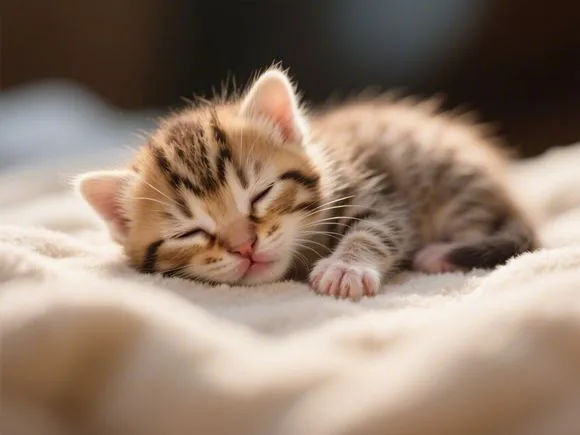
The First Few Weeks (0-4 Weeks): Mother’s Milk is Best
For the first few weeks of life, a kitten’s nutritional needs are ideally met entirely by their mother’s milk. It’s nature’s perfect food, providing everything a growing kitten requires.
The Magic of Colostrum
The very first milk produced by the mother cat, called colostrum, is liquid gold. It’s packed with vital antibodies that transfer passive immunity from the mother to her kittens, protecting them from diseases during their most vulnerable period before their own immune systems fully develop.
What if Mom Isn’t Around? Kitten Milk Replacer (KMR)
If a kitten is orphaned or the mother cannot nurse, a high-quality Kitten Milk Replacer (KMR) is the only safe and suitable alternative. You can find this at pet supply stores or veterinary clinics.
CRITICAL WARNING: Never feed kittens cow’s milk, goat’s milk, or other dairy products (or human baby formula!). Most cats are lactose intolerant, and these milks lack the specific balance of protein, fat, and essential nutrients kittens need. Feeding them can cause severe diarrhea, dehydration, and nutritional deficiencies.
Always follow the preparation instructions on the KMR label precisely. Mix only enough for one feeding at a time and warm it gently to body temperature (test on your wrist).

Feeding Orphaned Kittens
Feeding orphaned newborns requires patience and care:
- Positioning: Always feed kittens on their stomachs (prone position), never on their backs like a human baby, to prevent aspiration (milk entering the lungs).
- Method: Use a specially designed kitten nursing bottle or a syringe.
- Frequency: Newborns need feeding very frequently, often every 2-3 hours, around the clock.
- Stimulation: Very young kittens cannot urinate or defecate on their own. After each feeding, gently stimulate their genital/anal area with a warm, damp cotton ball or cloth to mimic the mother’s licking.
Weaning Time (4-8 Weeks): Introducing Solid Foods
Weaning is the gradual process of transitioning kittens from milk (mother’s or KMR) to solid food. This typically begins around 3-4 weeks of age and is usually complete by 6-8 weeks.
When to Start Weaning
Look for signs that kittens are ready: they might start nibbling at their mother’s food, their tiny teeth will begin emerging, and they become more mobile and curious.
How to Introduce Solids: The Gruel Stage
Start by mixing a small amount of high-quality wet kitten food with KMR (or warm water if weaning from mother’s milk) to create a thin paste or gruel. Offer this mixture in a shallow dish. Gradually thicken the gruel over several days by increasing the ratio of wet food to liquid.
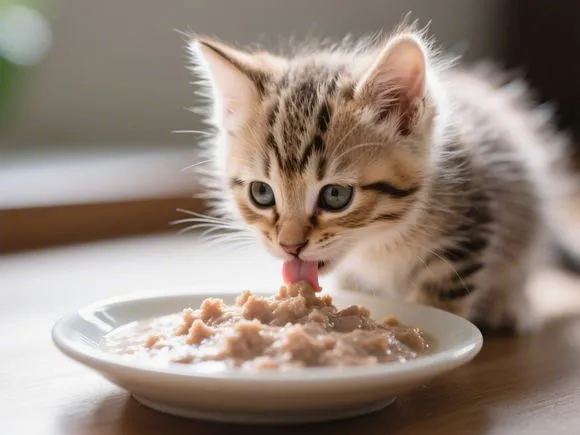
Transitioning to Kitten Food
As the kittens get used to the gruel, you can start offering just the high-quality canned (wet) kitten food. You can also introduce dry kitten kibble around this time, initially softened with a little warm water or KMR to make it easier to chew and digest. Always choose food specifically formulated for “kittens” or “all life stages” that meets AAFCO nutritional standards.
Importance of Fresh Water
Once kittens start eating solid food, they need access to fresh, clean water at all times. Provide it in a shallow, heavy bowl that they can’t easily tip over.
Fueling Growth (8 Weeks to 6 Months): The Kitten Food Era
This is a period of rapid growth and high energy! Kittens need significantly more calories, protein, fat, vitamins, and minerals per pound of body weight than adult cats.
Why “Kitten” Food is Crucial
Food formulated specifically for kittens provides:
- Higher Calories: To fuel their high energy levels and rapid growth.
- More Protein: Essential for building strong muscles and tissues.
- Increased Fat: A concentrated source of energy and essential fatty acids.
- Specific Nutrient Balance: Correct levels of calcium and phosphorus for bone development.
- Essential Nutrients: Such as Taurine (vital for heart and eye health) and DHA (an omega-3 fatty acid crucial for brain and vision development). Adult cat food usually doesn’t meet these higher requirements.
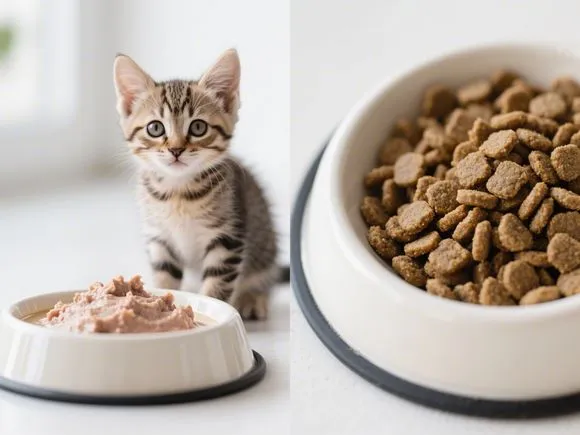
Wet Food vs. Dry Food: Pros and Cons
Both wet (canned) and dry (kibble) kitten foods can provide complete nutrition if they are high-quality and formulated for kittens. Many owners choose a combination:
- Wet Food: Higher moisture content (good for hydration), often more palatable.
- Dry Food: Convenient (can be left out for free-feeding, though portion control is important), may offer some dental benefits (though minor).
Mixing both provides variety and ensures adequate hydration.
Reading the Label: What to Look For
Look for a statement on the packaging indicating the food meets the nutritional levels established by the Association of American Feed Control Officials (AAFCO) for growth or all life stages. The first few ingredients should ideally be named meat sources (e.g., chicken, turkey, fish).
Feeding Schedule and Portion Sizes
Young kittens (8-16 weeks) thrive on multiple small meals per day – typically 3 to 4. As they get older (4-6 months), you can usually reduce this to 2-3 meals. Follow the feeding guidelines on the food packaging as a starting point, but adjust based on your kitten’s individual body condition, activity level, and growth rate. Avoid overfeeding, as obesity can start early.
Maturing Kittens (6 Months to 1 Year): Towards Adulthood
While growth starts to slow down after six months, kittens are still developing and generally require the enhanced nutrition of kitten food until they are about one year old (some large breeds like Maine Coons may need it longer).

Still Growing, Still Needing Kitten Food
Don’t switch to adult food too early! Continue feeding a high-quality kitten formula to support the final stages of growth and development.
Monitoring Weight and Adjusting Portions
As their growth rate slows, pay close attention to your kitten’s body condition. You should be able to feel their ribs easily with light pressure but not see them prominently. Adjust portion sizes as needed to prevent unwanted weight gain.
Planning the Transition to Adult Cat Food
Around their first birthday (consult your vet for the best timing for your specific cat), you can begin transitioning to adult cat food. This should be done gradually over 7-10 days to avoid digestive upset:
- Days 1-3: Mix 75% kitten food with 25% adult food.
- Days 4-6: Mix 50% kitten food with 50% adult food.
- Days 7-9: Mix 25% kitten food with 75% adult food.
- Day 10: Feed 100% adult food.
Foods Kittens Should NEVER Eat (Toxic and Dangerous)
Many common human foods are dangerous or toxic to cats and kittens. Their smaller size makes them even more susceptible to poisoning. Keep these foods completely out of reach:
- Onions, Garlic, Chives, Leeks: Damage red blood cells, causing anemia.
- Chocolate (all types): Contains theobromine and caffeine, toxic to cats.
- Alcohol: Highly toxic, even in small amounts.
- Caffeine (coffee, tea, soda, energy drinks): Causes restlessness, rapid breathing, heart palpitations.
- Grapes and Raisins: Can cause acute kidney failure.
- Xylitol: Artificial sweetener found in gum, candy, baked goods, some peanut butters. Causes insulin release and liver failure.
- Raw Meat, Fish, and Eggs: Risk of Salmonella and E. coli bacteria. Raw egg whites contain avidin, which interferes with biotin absorption.
- Bones (cooked or raw): Cooked bones splinter easily; raw bones pose a choking hazard.
- Dog Food: Lacks sufficient protein, taurine, and other nutrients cats need.
- Tuna (canned for humans): Okay as a very occasional tiny treat, but lacks balanced nutrition and can be high in mercury. Not a substitute for kitten food.
- Milk and Dairy Products: Most cats are lactose intolerant; causes digestive upset.
Watch Out for Toxic Houseplants!
Many common houseplants are toxic to cats if ingested. Lilies (all parts) are particularly deadly, causing kidney failure. Keep toxic plants out of reach or, better yet, out of your home entirely. Research any plant before bringing it into a house with cats. (Consider linking to ASPCA toxic plant list here).
If you suspect your kitten has ingested something toxic, contact your veterinarian or an emergency pet poison hotline immediately!
Treats and Supplements: Are They Necessary?
Treats in Moderation
Treats can be great for training and bonding, but they should be given sparingly. Choose treats specifically formulated for cats/kittens. Treats should make up no more than 10% of your kitten’s total daily caloric intake to avoid unbalancing their diet or causing weight gain. Avoid giving table scraps.
Supplements: Usually Not Needed
If you are feeding a high-quality, complete, and balanced commercial kitten food, additional vitamin or mineral supplements are generally unnecessary and can sometimes even be harmful by unbalancing the diet. Only give supplements if specifically recommended by your veterinarian for a particular health condition.
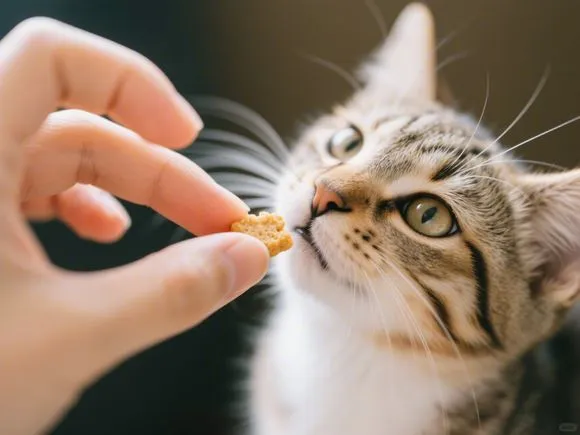
Don’t Forget the Water!
Water is absolutely essential for all bodily functions. Kittens, especially those eating dry food, need constant access to fresh, clean water.
- Availability: Ensure water bowls are always full and refreshed daily.
- Bowl Type: Use wide, shallow ceramic or stainless steel bowls, which are easy to clean and less likely to harbor bacteria than plastic. Some cats prefer running water, so a pet water fountain can encourage drinking.
- Placement: Keep water bowls separate from food bowls and litter boxes.
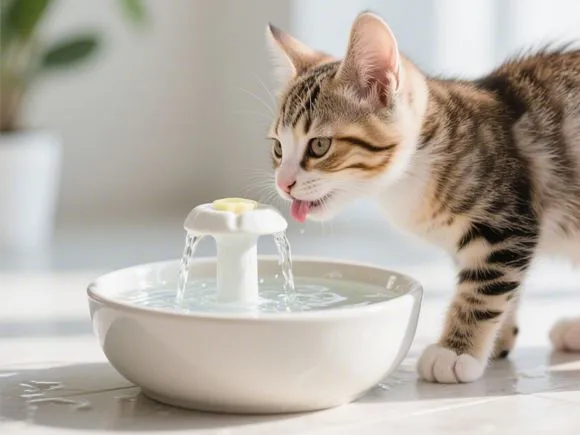
Frequently Asked Questions (FAQ)
Q: Can kittens drink cow’s milk?
A: No. As mentioned, most cats are lactose intolerant, and cow’s milk doesn’t provide the right nutrition. Stick to mother’s milk or KMR for newborns, and water for weaned kittens.
Q: How often should I feed my kitten?
A: Very young kittens (under 4 months) need 3-4 small meals per day. From 4-6 months, 2-3 meals are usually sufficient. After 6 months, twice-daily feeding is common, which can continue into adulthood.
Q: When can kittens eat dry food exclusively?
A: While kittens can technically eat dry food once their teeth are strong enough, offering wet food provides crucial hydration. Many vets recommend a mix of wet and dry, or primarily wet food, throughout a cat’s life. If feeding only dry, ensure your kitten drinks plenty of water.
Q: Can I give my kitten human food scraps?
A: It’s generally best to avoid it. Many human foods are unsafe (see the toxic list!), high in calories, fat, or sodium, and lack the balanced nutrition kittens need. Stick to high-quality kitten food and appropriate treats.
Q: What’s the “best” brand of kitten food?
A: There isn’t one single “best” brand. Focus on choosing a food that meets AAFCO standards for kitten growth, uses high-quality ingredients (named meat sources high on the list), and that your kitten enjoys and thrives on. Your veterinarian can offer excellent recommendations based on your kitten’s individual needs.
Conclusion: Setting Your Kitten Up for a Healthy Life
Understanding what kittens eat is fundamental to raising a healthy, happy cat. By providing age-appropriate, high-quality nutrition—from mother’s milk or KMR in the beginning, through the crucial kitten food stage, and avoiding dangerous human foods—you’re giving your tiny feline the best possible start. Remember to provide constant access to fresh water and monitor their growth and body condition.
Enjoy the incredible journey of watching your kitten grow! With the right care and nutrition, you’ll have a wonderful companion for years to come.
Actionable Advice: Always consult your veterinarian for personalized advice regarding your kitten’s specific dietary needs and health. They are your best resource for ensuring your kitten thrives.
Disclaimer: This article provides general informational purposes only and does not constitute veterinary advice. Always consult with a qualified veterinarian regarding the health and care of your pet.